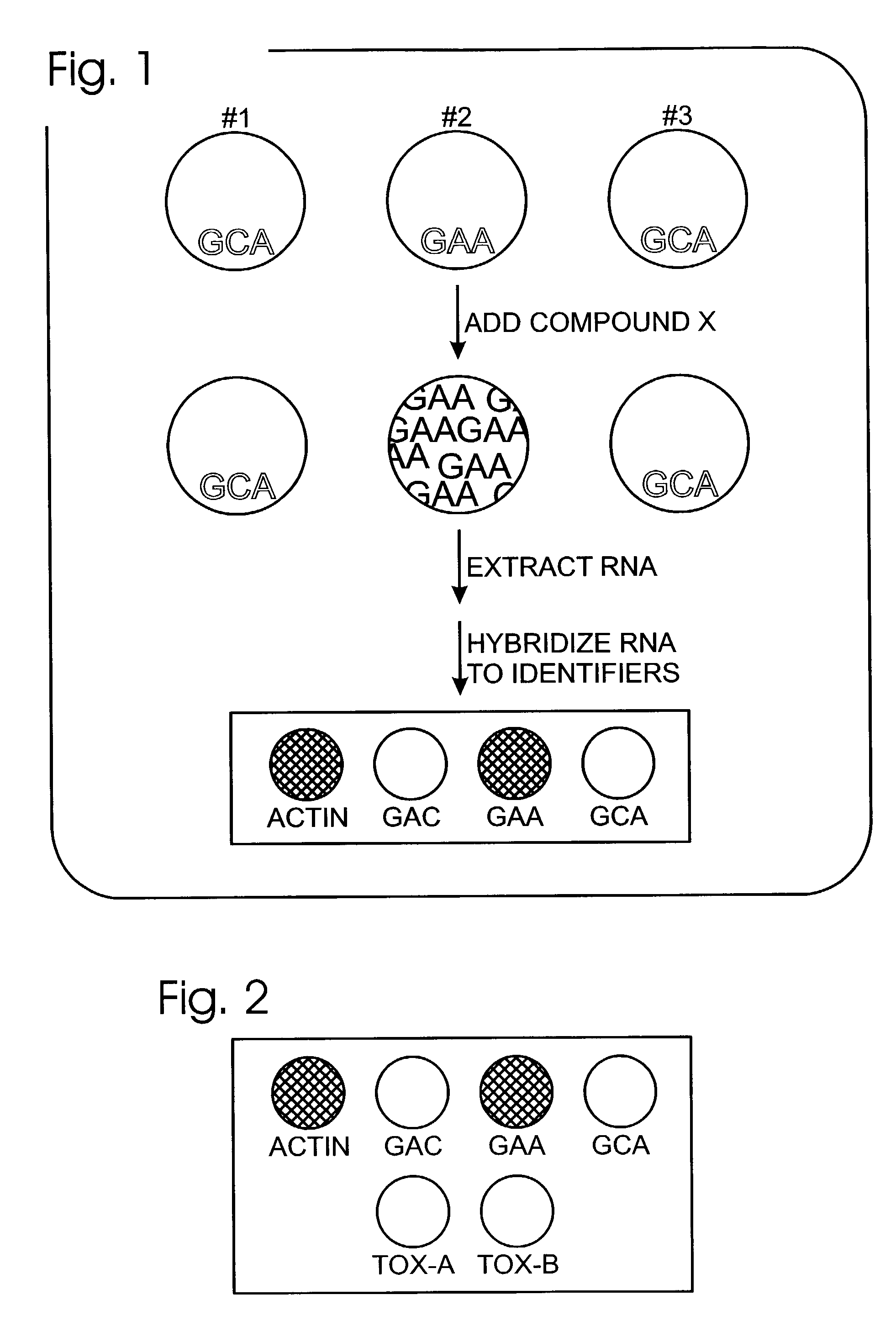Biological assays using coded RNA reporters
a reporter and gene technology, applied in the field of biological assays using coded rna reporters, can solve the problems of inability to distinguish and quantify efficiently a large number of reporter proteins within a single container, and inability to meet the requirements of high-throughput hybridization conditions
- Summary
- Abstract
- Description
- Claims
- Application Information
AI Technical Summary
Benefits of technology
Problems solved by technology
Method used
Image
Examples
example 1
[0039]This example, shown in FIG. 1, illustrates the use of a reporter cell library to measure the efficacy and specificity of a candidate receptor-modulator. A reporter cell library that includes three cell populations is illustrated schematically. Each cell population expresses, from a transfected plasmid expression vector, a distinct receptor (#1, #2, or #3) as effector. Each cell population also contains a reporter plasmid that directs the expression of a specific RNA reporter when the distinct receptor is activated. In this example, the reporter genes produce distinguishable RNA reporters at comparable low levels before modulator addition. RNA reporters are exemplified as including distinct sequence features GAC, GAA, and GCA. With addition of the modulator (compound X), the cell population expressing receptor #2 is shown to up-regulate the level of its reporter RNA (GAA).
[0040]To conduct a multiplexed analysis of RNA levels, RNA is extracted from the cell library, following tr...
example 2
[0042]This example, shown in FIG. 2, illustrates an expanded analysis with the labeled RNA from Example 1. In the expanded analysis, compound also is analyzed for a toxic effect on the reporter cell library. As shown, the identifier sequence array also includes identifier polynucleotides for Tox-A and Tox-B. Current methods for analyzing the toxic effects of compounds on cells are based on the regulation of the expression of genes involved in detoxification. Typically, this is done by the quantification of mRNA levels. Therefore, additional spots on the array may correspond to those genes (i.e., Tox-A and Tox-B) whose level correlates with compound toxicity. In the example of FIG. 1, not only is compound X specifically able to activate receptor 2, but compound X also likely is non-toxic due to the absence of any signal in the Tox-A and Tox-B spots.
example 3
[0043]This example illustrates an exemplary assay involving small interfering RNAs (siRNAs). These RNAs are typically small (e.g., 20–25 base pair) double-stranded RNAs that may knock down or knock out the expression of gene(s) that are sufficiently homologous to either of the RNA strands in the duplex, in a phenomenon termed RNA interference (RNAi). In this assay, cells are transfected with one or more siRNAs (or antisense sequences and / or a complementary sense sequences), and RNA reporters as described herein are used to read out the effects of the siRNAs on multiple pathways. The siRNAs may be used alone, as sole modulators, or they may be used with one or more other compounds, for example, as described above, to identify the mechanism of action of the compounds.
PUM
| Property | Measurement | Unit |
|---|---|---|
| fluorescent | aaaaa | aaaaa |
| fluorescence | aaaaa | aaaaa |
| length | aaaaa | aaaaa |
Abstract
Description
Claims
Application Information
 Login to View More
Login to View More - R&D
- Intellectual Property
- Life Sciences
- Materials
- Tech Scout
- Unparalleled Data Quality
- Higher Quality Content
- 60% Fewer Hallucinations
Browse by: Latest US Patents, China's latest patents, Technical Efficacy Thesaurus, Application Domain, Technology Topic, Popular Technical Reports.
© 2025 PatSnap. All rights reserved.Legal|Privacy policy|Modern Slavery Act Transparency Statement|Sitemap|About US| Contact US: help@patsnap.com

